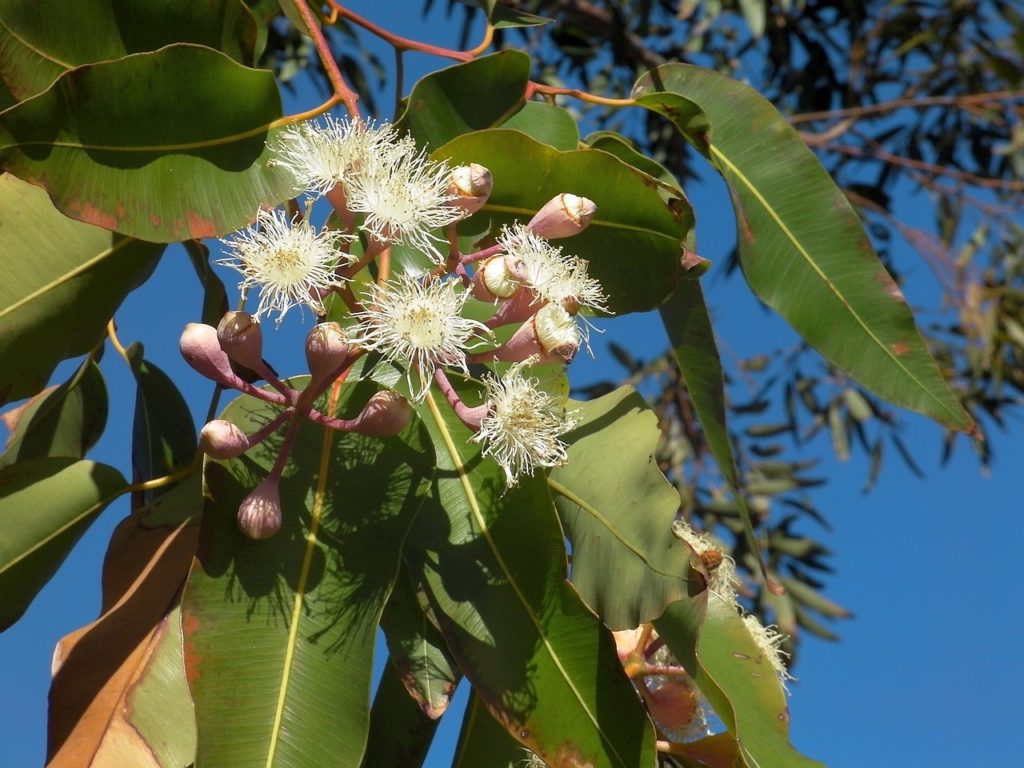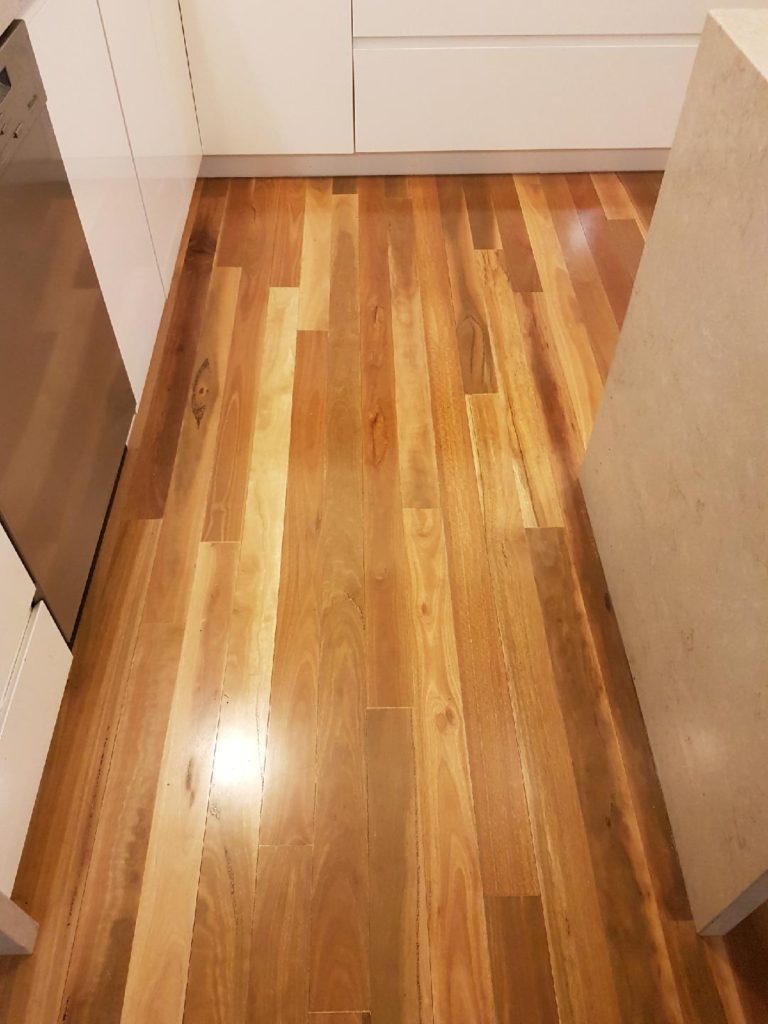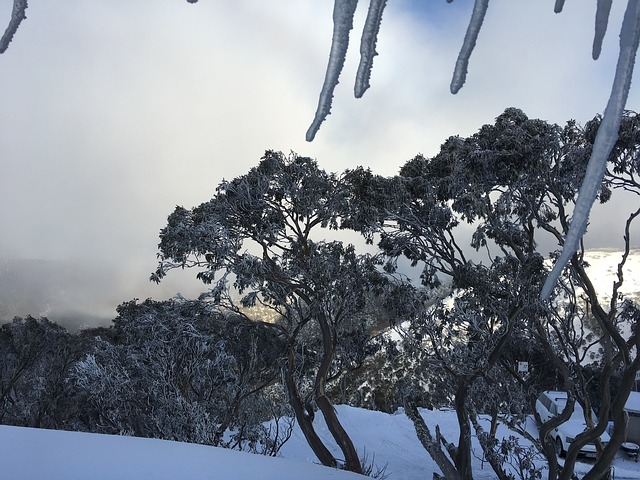Learn English while learning about daily life in Australia, with Rob McCormack
Podcast Number 101 – Eucalyptus – Australia’s Forest Tree
Hi,
Almost everywhere that you look in the Australian bush, you can see eucalyptus trees. These trees, apart from a few exceptions, are native only to Australia. Like the kangaroo and the koala, the eucalyptus tree somehow represents the uniqueness of Australia. In this podcast, I would like to tell you a little about these unique trees.
I regularly go for walks along bush tracks near my home in an outer suburb of Melbourne. These tracks wind their way alongside the Yarra River and through many kilometres of bushland. This bushland, as is the case throughout Australia, is full of eucalyptus trees – large and small, young and old. They are also planted by the local council on the grass verges of our towns and cities. They are found in parks, gardens and along roadways. They are found almost everywhere in Australia, including even our coldest alpine regions.
There are many different types of eucalyptus trees. In fact, there are over 700 different species of trees which make up the genus called Eucalyptus. Some are small trees while others grow to over 90 metres. Incredibly, there is a eucalyptus tree in Tasmania which is 99.8 metres high. This tree has a nickname – it is called ‘Centurion’ – a fitting name for a very grand tree indeed. Each eucalyptus species is different in some minor respect to the next, but there are some features which all eucalyptus trees have.
Probably the most important distinguishing features of eucalyptus trees are their special buds, flowers and fruits, which are unlike those of any other tree. They are commonly called gum nuts. They vary in shape, but are usually shaped a bit like a bell, a cone or a wine glass. The buds have a unique cover over the large end, a bit like a hat or a cap. The scientific term for the cover is operculum. It’s because of the operculum that these trees are named eucalyptus. This name comes from the Greek language and means ‘well covered’. When it’s time for the flowers to bloom, the cover or operculum falls off and the colourful stamens are exposed. These are the flowers. There are no petals on the flowers, just the long colourful stalks or stamens. The colours can be white, cream, yellow, pink, or red, depending on the species. As you might expect, the colourful eucalyptus flowers are popular with bee keepers. Honey produced from eucalyptus forests is especially sweet and unique. Once the flowers are finished, the seeds are ready to be released from the gum nuts. The hard gum nut eventually falls to the ground. If you are walking under a eucalyptus tree with soft shoes or bare feet, treading on a gum nut can be a little painful.
The bark of eucalyptus trees varies from species to species. For example, some have very rough bark with deep cracks while others have silky smooth bark, almost like skin. Their colours vary as well, from dark brown to yellow to white. Each year, many eucalypts will shed their bark, often in different ways. Sometimes the barks hangs down like long ribbons which cling to the tree. Often these bark ribbons will hang there for months, making the tree look like it is shedding its skin like a snake.

A eucalyptus tree near the Yarra River in Melbourne. Notice the ribbons of old bark shedding from the trunk and branches.
Nearly all eucalyptus trees are evergreen, which means they keep their green leaves all year round. Notwithstanding that, eucalyptus trees do drop quite a few leaves and bits of bark throughout the year, so it is usually quite messy under a big eucalyptus tree. If you have one in the garden, you will always be cleaning up with the rake. Interestingly, the main food of the koala is the leaves of eucalyptus trees.
Another interesting feature about eucalyptus trees is the fact that many species produce oil in their leaves. This oil can be extracted and has many uses, including in cleaning products and even as an insect repellent. It is this oil in the leaves which makes eucalyptus trees likely to burn easily. Unfortunately, a bushfire in a eucalyptus forest will spread quickly, spreading from one tree to the next as the oil vapour from the leaves burns. Australia has a long history of large bushfires which devastate the landscape (see Podcast 23).
On the positive side, these trees are full of character. The thing about eucalyptus trees which I find fascinating is that they all look different, even within the same species. It’s almost as if they are like people. They come in all shapes and sizes. Their branches are almost always bent and crooked in different ways. Each tree has its own look, its own personality in a way.
Eucalyptus trees produce a strong and hard timber which is used a lot as a building material in Australia, such as in houses, bridges, power poles, fences and retaining walls. It is also used extensively for the making of fine furniture. Furthermore, it is a wonderful material to use for flooring. Our house has hardwearing eucalyptus wood flooring from the spotted gum eucalyptus tree which grows in forests down the east coast of Australia. We chose it because of its beautiful rich colours and also its hardness. Its outstanding colour and warm feeling under foot makes us feel great every time we set foot on it.
My favourite eucalyptus tree is the snow gum. These trees live in the mountain regions of Australia from 1300 metres to 1800 metres high. They are very hardy indeed and can survive the freezing temperatures and very strong icy winds of a winter in the Australian Alps. Even more so than other eucalyptus trees, they often seem to be especially bent and twisted in their growth, almost as if they are hunching over to withstand the cold temperatures and strong wind. The bark of their trunks is mostly white and smooth. When hiking in the mountains, you really know you are getting high up when the snow gums start appearing. In 2014 my wife and I hiked to the summit of Victoria’s highest mountain, Mt Bogong, 1986 metres high. One of my most vivid memories is of the final climb through the snow gums and out onto the bare mountain top above the tree line. It meant that our final goal of reaching the summit was getting near.
Australians often use the term gum trees to mean eucalyptus trees. This is because some eucalyptus trees, but not all, exude a sticky gum from cracks in their bark. It’s probably not important which term you use. If you talk about gum trees or eucalyptus trees, every Australian will still know exactly what you mean.
https://www.youtube.com/watch?v=MLWzPQmd5sc
If you have a question or a comment to make, please leave it in the comments box at the bottom of this page. Or, you can send me an email at rob@slowenglish.info. I would love to hear from you. Tell me where you live, a little bit about yourself and what you think of my Slow English podcast. I will write back to you, in English of course. If you would like to take a short quiz to see if you have understood this podcast, you will also find it on my website. Goodbye until next time.
Rob
(My thanks to Chris Frankenberg for his valuable input into the content of this podcast episode.)
Podcast 101 Quiz - Did you understand the podcast?
You can take the quiz as many times as you like.
Vocabulary
alongside = next to
alpine = an area high in the mountains
appearing = showing, to come into view
bare = (here) no trees
bark = the covering of a tree trunk
bee keepers = people who keep bees and collect their honey
bell = a hollow metal object which makes a sound when hit
bent = not in a straight line
bloom = when flowers open up and show their colours
building material = things used to make building, for example wood, concrete, bricks, etc
bush = forest
bushland = an area of land with forest or bush
cap = a small hat, a baseball hat
character = (here) the good things about a person’s personality
cling = hold onto
cone = a shape which has a sharp closed end and is open at the other end
cover = lies over the top of something so that you can’t see it
crack = a long shaped hole which is very thin
crooked = another word for bent, but usually not in a good way
devastate = to destroy, damage or break
distinguishing = used to identify one thing as different to another thing
eventually = finally
exactly = (here) without any doubt
exceptions = different from normal
extensively = (here) a lot
extracted = taken from
exude = when a liquid comes out of something
fascinating = when something is very, very interesting
features = the characteristics
fitting = fits well
furniture = tables, chairs, cupboards, desks, etc
genus = a scientific word to describe a group of plants or animals. Species are part of a genus
hardwearing = will not wear out or break easily, very strong
hardy = strong, can live in hot or dry places
hiking = to walk through the bush or forest or mountains
hunching = bending over
incredibly = almost hard to believe
insect repellent = something which makes insects die or go away
local council = a level of government that manages local issues – see https://slowenglish.info/?p=2132
messy = when things are not well organised
minor respect (in a) = a detail which is not very important
native = (here) comes from, only found in
nickname = a special name which is different to the correct name. Usually made for fun
notwithstanding = despite this, even though
outer suburb = an area of a city where people live, in this case, a long way from the city centre
outstanding = very, very good, better than the others
petals = part of a flower, shaped like a leaf
planted = when young trees are first put in the ground
power poles = long round length of wood, metal or concrete – here used to hold the electricity wires
rake = used in a garden to pull all the leaves together
regions = an area of land
regularly = often
released = (here) dropped
represents = stands for, takes the place of, is a symbol for
retaining walls = a wall in the garden to hold back the ground
ribbons = long pieces of colourful material
scientific term = a word used in science
seeds = very small part of a plant which is put into the ground and grows into a plant
set foot = to go into
shedding = when something falls off
silky = like silk, usually very soft and smooth
species = a scientific word to describe a group of plants or animals with the same features
spread = when something goes from one place to another
stalks = long, thin parts of a plant
stamens = part of a flower
sticky = when something stays on your fingers if you touch it, for example honey
summit = the top of a mountain
survive = to stay alive
timber = wood
treading = to walk on with your feet
under foot = when something is under your foot, usually talking about floors or the ground
unique = when there is nothing else like this
vapour = when a liquid goes into the air
verges = the strip of land next to the road, between the houses and the road
vivid memories = the things you remember very clearly
withstand = not to give in, not to break




May 15, 2022 at 5:38 pm
Hi Rob,
I found a Chinese who described eucalyptus in a different perspective. The eucalyptus culture originated from the primitive aborigines living in the Australian continent and was inherited and developed after the western colonists entered the Australian continent. After more than 200 years of development and integration, eucalyptus trees on a spiritual level have become the spiritual pursuit and symbol of Australian people, showing the spirit of growth and evolution under difficult conditions, courage, hard work and tenacious development. It makes sense I think. Do you think so too?
It is also reported that Australian scientists have used X-rays to find trace amounts of gold in the leaves of eucalyptus trees growing in gold-mining areas, which is believed to be the first time gold has been found naturally occurring in living organisms. I think this discovery will help people explore for gold ore in a more environmentally friendly and cheaper way.
By the way, in the sentence, “One of my most vivid memories is of the final climb through the snow gums and …”, why is the preposition “of” used here?
Thank you very much for your wonderful sharing.
Best regards,
Dep
May 17, 2022 at 11:44 pm
Hi Dep,
Many thanks for your comment. I haven’t heard of that perspective about eucalyptus before, but it is certainly possible for some people. However, I think for the average Australian the situation is a little less complicated, without the spiritual aspect. However, that is only my view. That’s also interesting to hear about gold and eucalypts. It certainly could point to different ways of searching for gold.
Regarding the use of the prepostition ‘of’ – this is used with words such as memories or recollections. We have memories of things. We have recollections of things.
I hope that helps.
I hope you are well. Have a great day.
Rob.
February 26, 2021 at 5:26 am
I’m glad you mentioned that most eucalyptus trees stay green throughout the whole year. My sister is looking for a plant supplier since she wants more shade in the yard of her new classic-style home. I’ll share this info to help her decide if eucalyptus trees would be a good option for her property!
February 26, 2021 at 9:05 pm
Hi Rebecca. Thanks for your comment. Eucalypt trees will certainly give some shade.
Cheers,
Rob
February 5, 2020 at 8:05 am
Hello Rob
I usually work on podcasts from the BBC or The Guardian with my students.
But looking for other sources on the net I found yours and I found them really interesting.
I was just wondering : have you ever considered doing the same thing but for more advanced learners?
Wishing you a good day from the other side of the planet !!! (FR)
February 6, 2020 at 10:37 pm
Hi Laurence,
Many thanks for your comment and your kind words about my podcast. I must admit that I have not considered targeting a more advanced audience, but that is an interesting thought.
Thanks for your feedback.
All the best from Melbourne.
Rob
March 12, 2019 at 4:39 pm
Republic of Abkhazia is another great place which is full of eucalyptus trees. If I remember well, Abkhazia has the second count of eucalyptus in the world after Australia. It is fantastic because Republic of Abkhazia is a very small country. For example it is about 40 thousands people live in Sukhumi, the capital of Abkhazia. It is my lovely place which has fantastic nature and climate.
March 13, 2019 at 8:50 am
Hi Sergey,
Many thanks for your comment. The climate in Abkhazia must be similar to that of Australia in many ways, since both our countries have eucalyptus trees. Thanks for reminding us that other countries besides Australia have eucalyptus trees.
Have a great day.
Rob
June 5, 2018 at 10:09 am
Hello Rob! I am living in Far East of Russia and here is not eucalyptus trees. But I bought in a drug store a small bottle of eucalyptus oil. The oil is smells so good! We use it in aroma lamp. I like the smell. Every your podcast is informative and interesting!
Thank you very much!
June 5, 2018 at 4:24 pm
Hi Sergey,
Many thanks for your very kind comments. I’m glad you like the smell of the eucalyptus oil.
Thanks again for your feedback.
Have a great day.
Rob